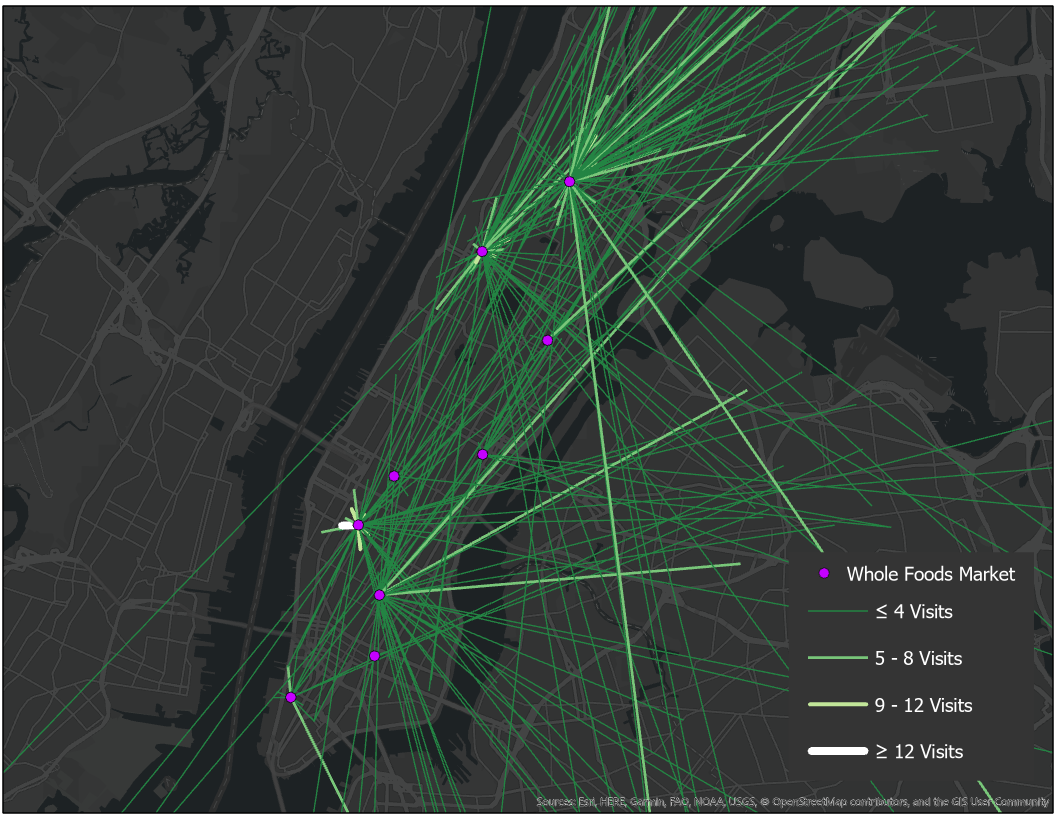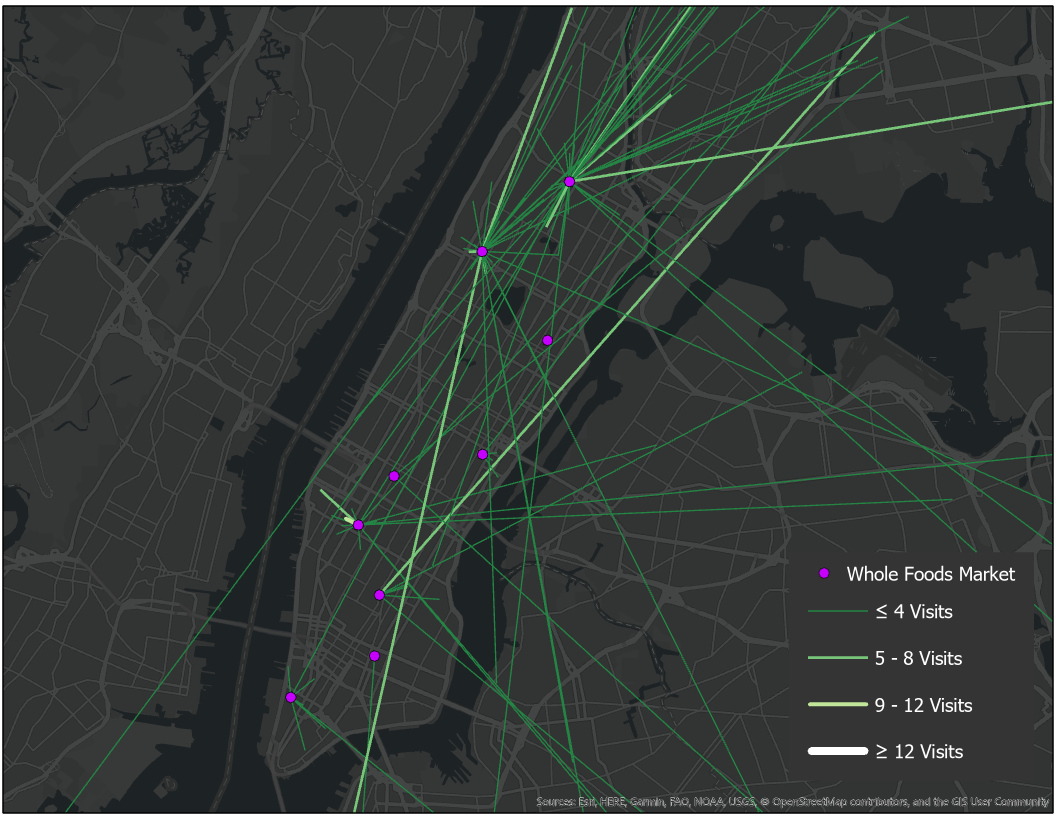Tracking Visitor Counts before and during COVID-19 Pandemic¶
Using data provided by SafeGraph, we were able to track the frequency of shoppers for select store brands, and also categorizing the freqeuncy of shopper visits based on their dwell times. Since the start of the pandemic, the dynamics of shopping has changed, where the number of visitors in stores changed once quarantine started. For this analysis, New York City was analyzed.¶
In [1]:
import pandas as pd
import geopandas as gpd
import json
import numpy as np
import matplotlib.pyplot as plt
from matplotlib.pyplot import figure
Create the Bucket Dwell Time Class¶
In [2]:
class Bucketed_Dwell_Time:
def __init__(self, lst):
self.lst = lst
def average(self, lst):
return sum(lst) / len(lst)
def listSum(self, lst):
total = 0
item = 0
while(item < len(lst)):
total = total + lst[item]
item += 1
return total
def findMedian(self, lst):
n = len(lst)
lst.sort()
if n % 2 == 0:
median1 = lst[n//2]
median2 = lst[n//2 - 1]
median = (median1 + median2)/2
else:
median = lst[n//2]
return median
def organizeDwells(self):
dwell1 = []
dwell2 = []
dwell3 = []
dwell4 = []
dwell5 = []
for b in self.lst:
for k, v in b.items():
if k == '<5':
dwell1.append(v)
elif k == '5-20':
dwell2.append(v)
elif k == '21-60':
dwell3.append(v)
elif k == '61-240':
dwell4.append(v)
else:
dwell5.append(v)
self.dwell1 = dwell1
self.dwell2 = dwell2
self.dwell3 = dwell3
self.dwell4 = dwell4
self.dwell5 = dwell5
def bDwell_avg(self):
self.organizeDwells()
bcktDwell_avg = {'<5': self.average(self.dwell1), '5-20': self.average(self.dwell2),
'21-60': self.average(self.dwell3),'61-240': self.average(self.dwell4),
'>240': self.average(self.dwell5)}
return bcktDwell_avg
def bDwell_median(self):
self.organizeDwells()
bcktDwell_mdn = {'<5': self.findMedian(self.dwell1), '5-20': self.findMedian(self.dwell2),
'21-60': self.findMedian(self.dwell3),'61-240': self.findMedian(self.dwell4),
'>240': self.findMedian(self.dwell5)}
return bcktDwell_mdn
def bDwell_count(self):
self.organizeDwells()
bcktDwell_count = {'<5': self.listSum(self.dwell1), '5-20': self.listSum(self.dwell2),
'21-60': self.listSum(self.dwell3),
'61-240': self.listSum(self.dwell4), '>240': self.listSum(self.dwell5)}
return bcktDwell_count
Get Store Data¶
In [3]:
def getStoreData(store, week):
getstore = week[week['location_name']== store]
bucketDwell = getstore['bucketed_dwell_times']
bucketDwell_list = []
for v in bucketDwell:
v = json.loads(v)
bucketDwell_list.append(v)
return bucketDwell_list
New York City Data¶
In [4]:
read = pd.read_csv("NY_week0302.csv")
NY_pre1 = pd.DataFrame(read)
read2 = pd.read_csv("NY_week0309.csv")
NY_pre2 = pd.DataFrame(read2)
read3 = pd.read_csv("NY_week0323.csv")
NY_post1 = pd.DataFrame(read3)
read4 = pd.read_csv("NY_week0330.csv")
NY_post2 = pd.DataFrame(read4)
store_list = ['McDonald\'s', 'Target', 'Starbucks', 'Whole Foods Market', 'Trader Joe\'s']
Loop through the store list to get total visitor counts, as average visitor counts.¶
In [5]:
if __name__ == "__main__":
week_1_averages = {}
week_1_count = {}
for store in store_list:
dwell = getStoreData(store, NY_pre1)
d = Bucketed_Dwell_Time(dwell)
avg = d.bDwell_avg()
count = d.bDwell_count()
week_1_averages.update( {store: avg} )
week_1_count.update({store: count})
week_2_averages = {}
week_2_count = {}
for store in store_list:
dwell = getStoreData(store, NY_pre2)
d = Bucketed_Dwell_Time(dwell)
avg = d.bDwell_avg()
count = d.bDwell_count()
week_2_averages.update( {store: avg} )
week_2_count.update({store: count})
week_3_averages = {}
week_3_count = {}
for store in store_list:
dwell = getStoreData(store, NY_post1)
d = Bucketed_Dwell_Time(dwell)
avg = d.bDwell_avg()
count = d.bDwell_count()
week_3_averages.update( {store: avg} )
week_3_count.update({store: count})
week_4_averages = {}
week_4_count = {}
for store in store_list:
dwell = getStoreData(store, NY_post2)
d = Bucketed_Dwell_Time(dwell)
avg = d.bDwell_avg()
count = d.bDwell_count()
week_4_averages.update( {store: avg} )
week_4_count.update({store: count})
Organize the Data¶
In [6]:
def dataOrganize(weekList, store):
FiveMin = []
TwentyMin = []
SixtyMin = []
_240 = []
GreaterThan240 = []
for item in weekList:
for k, v in item.items():
for i in v.items():
if k == store:
if i[0] == '<5':
FiveMin.append(i[1])
elif i[0] == '5-20':
TwentyMin.append(i[1])
elif i[0] == '21-60':
SixtyMin.append(i[1])
elif i[0] == '61-240':
_240.append(i[1])
else:
GreaterThan240.append(i[1])
output = {'<5': FiveMin, '5-20': TwentyMin, '21-60': SixtyMin, '61-240': _240, '>240': GreaterThan240}
return output
In [7]:
week_list = [week_1_averages, week_2_averages, week_3_averages, week_4_averages]
organizedData = {}
for store in store_list:
organizedData.update({store: dataOrganize(week_list, store)})
Define a function that creates a grouped histogram¶
- Used for looping through the store list.
- The Histogram output will show the distrubtion over the 4 week period of New York City
In [8]:
def groupHistogram(store, data, txtInput):
for k, v in data.items():
if k == store:
for i in v.items():
if i[0] == '<5':
bar1 = i[1]
if i[0] == '5-20':
bar2 = i[1]
if i[0] == '21-60':
bar3 = i[1]
if i[0] == '61-240':
bar4 = i[1]
else:
bar5 = i[1]
barGroups = [bar1, bar2, bar3, bar4, bar5]
groupNames = ['<5', '5-20', '21-60','61-240','>240']
df = pd.DataFrame(barGroups, index = groupNames, columns = ['March 2nd - March 8th', 'March 9th - March 15th', 'March 23rd - March 29th', 'March 30th to April 5th'])
colorScheme = ['#63a02c', '#b2df8a', '#1f78b4', '#43a0df' ]
ax = df.plot.bar(rot=0, figsize=(15,10), zorder = 5, color = colorScheme, edgecolor = "white", fontsize = 20)
plt.grid(axis='y', linestyle='--', linewidth=0.8)
plt.xlabel('Dwell Time (Minutes)',size = 25)
plt.ylabel(txtInput+' Number of Visitors', size = 25)
plt.title("New York City: "+ txtInput +" Number of Visitors by Dwell Time at "+store, size = 20)
plt.legend(loc=1, prop={'size': 18})
plt.savefig('NewYorkCity_'+store+'_'+txtInput+'.png')
Export the average number of visitors by dwell time at each store brand¶
In [9]:
# Remember - store_list = ['McDonald\'s', 'Target', 'Starbucks', 'Whole Foods Market', 'Trader Joe\'s','Walgreens','CVS','7-Eleven']
for s in store_list:
groupHistogram(s, organizedData, "Average")
Overall, you can see a difference in visitors in the later two weeks compared to the first two weeks. For the bucketed dwell time of over 240 minutes, it is suggested that some of that data can be from employees who work at that brand store.¶
Export the total count of visitors by dwell time at each store brand¶
In [10]:
wkCount_list = [week_1_count, week_2_count, week_3_count, week_4_count]
countData = {}
for store in store_list:
countData.update({store: dataOrganize(wkCount_list, store)})
In [11]:
for s in store_list:
groupHistogram(s, countData, "Total")
Just like the results for average visitors, the results show a similar trend for total count of visitors.¶
Map out the frequency of store visits before and during the pandemic lockdown. To do this, we got the XY centroid coordinates in the visitor's home U.S. Census Block Group. Once this was retrieved, we created lines from the visitor's home Census Block Group, to the store's XY location.¶
In [12]:
import shapely
import ast
getFrequency function calculates the total visitors based on store brand and which two week periods they were put in.¶
In [13]:
def getFrequency(wk1,wk2):
wk1_visit_cbg = []
wk1_visit_cbg_count = []
wk1_poi = []
wk1_brand_list = []
wk2_visit_cbg = []
wk2_visit_cbg_count = []
wk2_poi = []
wk2_brand_list = []
table1 = pd.DataFrame(columns = ['brand','poi_cbg','visitor_cbg'])
table1['brand'] = wk1['brands']
table1['poi_cbg'] = wk1['poi_cbg']
visit_count1 = wk1['visitor_home_cbgs']
table1['visitor_cbg'] = wk1['visitor_home_cbgs']
for index, row in table1.iterrows():
visits = row['visitor_cbg']
p = row['poi_cbg']
b = row['brand']
visits = ast.literal_eval(visits)
for k, v in visits.items():
wk1_visit_cbg.append(k)
wk1_visit_cbg_count.append(v)
wk1_poi.append(str(p))
wk1_brand_list.append(b)
table1 = pd.DataFrame(columns = ['brand','poi_cbg_wk1','visitor_cbg_wk1','visitor_count_wk1'])
table1['brand'] = wk1_brand_list
table1['poi_cbg_wk1'] = wk1_poi
table1['visitor_cbg_wk1'] = wk1_visit_cbg
table1['visitor_count_wk1'] = wk1_visit_cbg_count
table2 = pd.DataFrame(columns = ['brand','poi_cbg','visitor_cbg'])
table2['brand'] = wk2['brands']
table2['poi_cbg'] = wk2['poi_cbg']
visit_count2 = wk2['visitor_home_cbgs']
table2['visitor_cbg'] = wk2['visitor_home_cbgs']
for index, row in table2.iterrows():
visits = row['visitor_cbg']
p = row['poi_cbg']
b = row['brand']
visits = ast.literal_eval(visits)
for k, v in visits.items():
wk2_visit_cbg.append(k)
wk2_visit_cbg_count.append(v)
wk2_poi.append(str(p))
wk2_brand_list.append(b)
table2 = pd.DataFrame(columns = ['brand','poi_cbg_wk2','visitor_cbg_wk2','visitor_count_wk2'])
table2['brand'] = wk2_brand_list
table2['poi_cbg_wk2'] = wk2_poi
table2['visitor_cbg_wk2'] = wk2_visit_cbg
table2['visitor_count_wk2'] = wk2_visit_cbg_count
table = pd.merge(table1, table2, how='left', left_on=['poi_cbg_wk1','visitor_cbg_wk1'], right_on = ['poi_cbg_wk2','visitor_cbg_wk2'])
return table
- getPOICoordinates gets the XY coordinates of the given store.
- getVisitCoordinates gets XY centroid coordinates of the Census Block Group the shopper resides in.
In [14]:
def getPOICoordinates(state, city, df):
shp = gpd.read_file("shp/"+city+"/"+state+"_BG.shp")
shp = shp.to_crs('epsg:4326')
shp = gpd.GeoDataFrame(shp)
poi_x = []
poi_y = []
df['GEOID'] = pd.to_numeric(df['GEOID'], errors='coerce')
shp['GEOID'] = pd.to_numeric(shp['GEOID'], errors='coerce')
data = pd.merge(frequency, shp, how='right',on = 'GEOID')
for index, row in data.iterrows():
poi_x.append(row['geometry'].centroid.x)
poi_y.append(row['geometry'].centroid.y)
data['poi_x'] = poi_x
data['poi_y'] = poi_y
del data['ANY UNNECESSARY FIELDS']
return data
def getVisitCoordinates(state, city, df):
shp = gpd.read_file("shp/"+city+"/"+state+"_BG.shp")
shp = shp.to_crs('epsg:4326')
shp = gpd.GeoDataFrame(shp)
visit_x = []
visit_y = []
df['GEOID'] = pd.to_numeric(df['GEOID'], errors='coerce')
shp['GEOID'] = pd.to_numeric(shp['GEOID'], errors='coerce')
data = pd.merge(frequency, shp, how='right',on = 'GEOID')
for index, row in data.iterrows():
visit_x.append(row['geometry'].centroid.x)
visit_y.append(row['geometry'].centroid.y)
data['visit_x'] = visit_x
data['visit_y'] = visit_y
del data['ANY UNNECESSARY FIELDS']
return data
This loops through the list of csv files in order to differentiate the frequency counts before and after quarantine started.¶
In [ ]:
period = ['pre','post']
for p in period:
if p == 'pre':
read = pd.read_csv("Week 1 csv")
pr1 = pd.DataFrame(read)
read2 = pd.read_csv("Week 2 csv")
pr2 = pd.DataFrame(read2)
if p == 'post':
read = pd.read_csv("Week 3 csv")
pr1 = pd.DataFrame(read)
read2 = pd.read_csv("Week 4 csv")
pr2 = pd.DataFrame(read2)
for s in store_list:
print("Calculating "+s+" in "+c+"...")
wk1_store = pr1[pr1['brands'] == s]
wk2_store = pr2[pr2['brands'] == s]
frequency = getFrequency(wk1_store, wk2_store)
freq_list = []
frequency['visitor_count_wk1'] = frequency['visitor_count_wk1'].fillna(0)
frequency['visitor_count_wk2'] = frequency['visitor_count_wk2'].fillna(0)
for index, row in frequency.iterrows():
total = row['visitor_count_wk1'] + row['visitor_count_wk2']
freq_list.append(int(total))
frequency['frequency'] = freq_list
del frequency['visitor_count_wk1']
del frequency['visitor_count_wk2']
del frequency['poi_cbg_wk2']
del frequency['visitor_cbg_wk2']
del frequency['brand_y']
frequency = frequency.rename(columns = {"brand_x":"brand","poi_cbg_wk1":"GEOID","visitor_cbg_wk1":"visitor_cbg"})
frequency = getPOICoordinates(st, c ,frequency)
frequency = frequency.rename(columns = {"GEOID":"poi_cbg","visitor_cbg":"GEOID"})
frequency = getVisitCoordinates(st,c,frequency)
frequency.to_csv('csv file location')
Next is arcpy, only used for ArcGIS Pro¶
In [ ]:
import arcpy
arcpy.env.overwriteOutput = True
def ExportXYtoLines(state, store, pr, data, output):
store = store.replace("'","")
store = store.replace(" ","")
store = store.replace("-","_")
XY_output = output + "/"+city+"_"+store+"_"+pr+"_FREQUENCY"
arcpy.XYToLine_management(data, XY_output, "poi_x", "poi_y", "visit_x", "visit_y", "Geodesic", "visitor_count")
diss_output = output + "/"+store+"_"+pr
statistics_fields = ["visitor_count","SUM"]
diss_fields = ["poi_x", "poi_y", "visit_x", "visit_y"]
stat_fields = [["visitor_count","SUM"]]
arcpy.Dissolve_management(XY_output, diss_output, diss_fields ,stat_fields, "SINGLE_PART")
arcpy.Delete_management(XY_output)
brand_store_output = output + "/"+store+"_"+pr+"_POINTS"
arcpy.management.XYTableToPoint(diss_output,brand_store_output,"poi_x", "poi_y")
output = r"Output gdb here"
for p in period:
for s in store_list:
csv = ("csv input here")
ExportXYtoLines(st, s, p, csv, output)
Once doing the code in arcpy, you can analyze and observe the frequency distributions for the first and last two weeks in this analysis. Here, you can find the frequency in the first two weeks is very high, while the later two weeks show less due to the limitations to shopping during the beginnings of quarantine.¶
Whole Foods Market - First Two Weeks

Whole Foods Market - Second Two Weeks

In [3]:
import os
os.system('jupyter nbconvert --to html NewYork_StoreVisits.ipynb')
Out[3]: